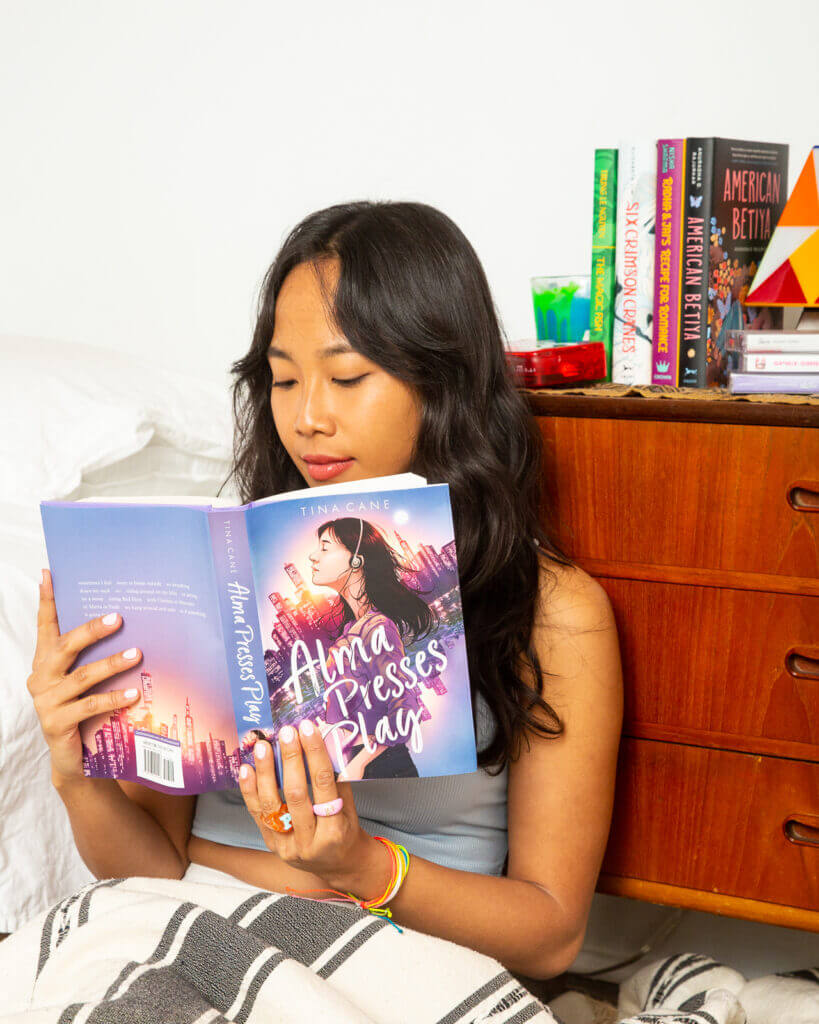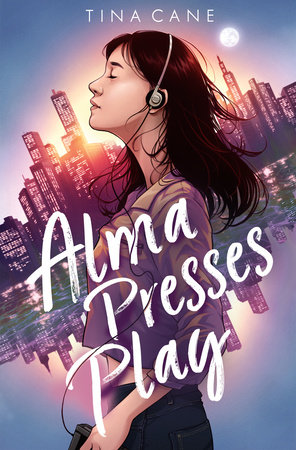
One of our favorite Book Nerd activities is going to book club! Book clubs create community, help us get through our TBR pile, discover new faves, and allow space to talk about our favorite characters. To help with your book club endeavors, we’ve created book club guides for some of our favorite YA titles. This book club guide will help you get the most out of reading Tina Cane’s Alma Press Play.
If you’re looking for other book club articles, check out 10 Easy Steps to Hosting a Virtual Book Club and don’t forget to tag @getunderlined whenever your book club meets!
Alma Presses Play Book Club Guide Pre-Reading Questions
- Have you ever felt caught between two identities? What was difficult about being pressured to choose between one identity and another?
- If you were to create a playlist to represent a particular period of your life, what songs would you include, and why?
- Are there foods that carry strong memories for you? Why do you think food plays such a significant role in how we understand our identities?
- What do you think it would have been like to grow up in the 1980s, before the creation of social media? Which aspects of being a teenager might have been easier? What might have been harder?
- How important do you think teenage friendships are in shaping the people we become
Alma Presses Play Book Club Guide Discussion Questions
- The word “girls” is used in several different ways in “On Our Block” (pp. 41–42). Why do you think Alma says, “Girls / which is what they are what we are too”? What does she mean? Throughout the book, what are some of the challenges of girlhood that Alma and the other girls experience?
- Several of the poems in this book take the form of lists (pp. 24–25, p. 26, p. 78, pp. 79–80, p. 81, p. 115, p. 209, p. 214). Choose one of these poems, and reread it at least three times. What do you start to notice? What makes a list an interesting form for a poem?
- Alma says that her Walkman “contains the mixtape of [her] life” (p. 51). What are some of the reasons that Alma listens to music? Which of these reasons resonate with you? Do you like music? Why? Why do you think the book is titled Alma Presses Play?
- On pages 89–90, Dario sings “Kung Fu Fighting” and squints his eyes while making “ching-chong sounds.” He says this cannot be racist because “It’s in the song!” Why do you think Alma and Clarissa laugh at him? What would you say to Dario in response?
- Alma begins practicing what she calls “mental kung fu” (p. 130) to deal with some of the problems she encounters. Do you think mental kung fu is a way for Alma to face her problems or escape them?
- Alma loves to read the thesaurus (p. 160), and many of the poems in this book include her reflections on language. Why do you think Alma enjoys thinking about words and their definitions? How do words and phrases such as “home” (p. 5), “ambivalent” (p. 92), “serendipity” (p. 94), and “call it quits” (p. 182) allow Alma to reflect on her own experiences?
- Tara asks Alma if she “wants to look more white” (p. 168), while Clarissa claims that Alma’s mother “broke the rules” of being Chinese by marrying a white man (p. 206). Where else do we see discrimination against multiracial people or interracial marriage in this book? How does this discrimination affect Alma and her family?
- Alma writes letters to the Greek goddess Persephone on pages 235–239 and 306. If you don’t know the story of Persephone, look it up. Why do you think Alma feels a connection to this particular goddess? Do you see any parallels?
- The final poem “Free” is repeated in slightly different variations three times throughout the book (p. 118, p. 255, p. 319). What do you think is the purpose of this repetition? Alma faces a difficult choice at the end of the book. How does she continue to find freedom?
- As students read the book, take note of famous figures like Andy Warhol, Quentin Crisp, Debbie Harry, and David Bowie, and have them research who they are. How do they fit into the counterculture?
Alma Presses Play Book Club Guide Beyond the Book
- Reflection:Alma Presses Play could be considered a coming-of-age story, a genre that depicts the transition from childhood to adulthood. Many of these stories, such as Mark Twain’s The Adventures of Huckleberry Finn and J. D. Salinger’s The Catcher in the Rye, have historically centered on white, male protagonists. How do you think race and gender affect what it means to come of age? Why do we need more coming-of-age stories about girls of color?
- Creative Writing: Write a poem inspired by a food you enjoy (p. 65) or a few lines from one of your favorite songs (pp. 85–86). Don’t feel obligated to make the poem about the food or song. Instead, as you see in the poems in this book, try exploring the ideas, feelings, memories, and other associations that the food or song evokes in you.
- Research: The Walkman, released in 1979, was a significant new technology because it allowed people to carry their music around with them wherever they went and listen to it privately on their headphones. For this reason, Alma writes that getting a Walkman was “the best thing that ever happened” to her (p. 51). Interview someone over the age of thirty about a technology that they associate with their youth. Research the technology. What was significant about it? How did it shape the experience of being a young person in that era? Does it still exist? What replaced it?
About the Author
Tina Cane grew up in downtown New York City during the ’70s and ’80s, surrounded by artists and writers and musicians, and she draws much of her creative inspiration from that era. The founder and director of Writers-in-the-Schools, RI, Tina also currently serves as the poet laureate of Rhode Island, where she lives with her husband and three children, who are also a major source of inspiration.
Educators’ guide written by Erica Kanesaka a Postdoctoral Fellow at the Pembroke Center for Teaching and Research on Women at Brown University. She specializes in Asian American studies and childhood studies.


